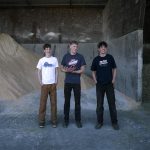
Studies from New Zealand’s Lincoln University Dairy farm, which have been included in the Tasmanian research, showed a 12 per cent reduction in emissions from milking fewer, higher producing cows.
Other factors identified in the studies include reducing supplement and nitrogen fertiliser inputs and improving pasture management.
The work led by DairyTas, was a first for Australian dairy.
It also drew on a breeding index developed in New Zealand to help dairy farmers select bulls to help them breed progeny with a lower environmental footprint.
The project, led by DairyTas and supported by agritech and herd improvement co-operative LIC the Tasmanian government and Serve-Ag, investigated how the industry could reduce carbon emissions.
Central to the findings was the need to breed a cow which, produces high milk solids relative to its liveweight, while lasting longer in the herd.
Former DairyTas sustainable dairying adviser Rachel Brown said genetics was the obvious starting point for the investigation, as cattle produce 60 to 65 per cent of the emissions from the state’s industry.
“This project showed you can milk less cows, but milk better cows,” Ms Brown said.
“With the right animals you can focus on profitability, not production.
“With the right cows and the right genetics, it flows through the whole business, and you can have good people, who can run the farm well.”
This project was a first for the Australian dairy industry and it drew on research from across the Tasman, specifically the HoofPrint breeding index developed by LIC.
The HoofPrint index allows farmers to select bulls based on their predicted ability to generate daughters that produce less methane and nitrogen per kilogram of milk solids over the animal’s entire life.
Dr Brown said tapping into the New Zealand dairy industry not only provided access to world-leading research, but the science was also applicable to Tasmania because of climate and farm system similarities.
Breeding for environmental and business gains requires a focus on the production and longevity of individual cows, according to New Zealand-based LIC environment and welfare manager Tony Fransen.
“It’s the right cow producing the right levels, driving overall efficiency,” he said.
“Then there’s lifetime efficiency – is the cow getting in calf every year? Is it early in the season?
“Does she have the health and conformation traits that means farmers keep her around longer?”
The next step to improving the environmental credentials and profitability of every generation, would be using sexed semen to breed from the best animals in each herd, Mr Fransen said.
Dairy farmers can find the project’s ’10-step guide’ on the Dairy Australia website.
























